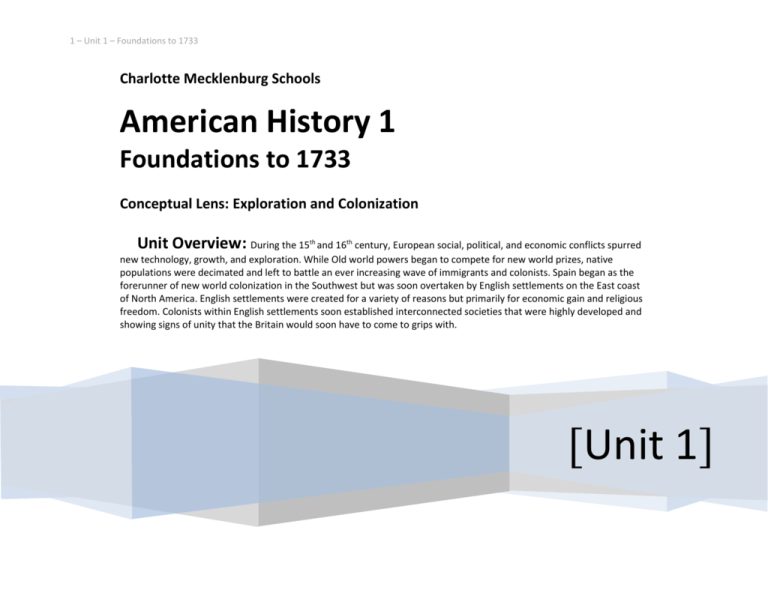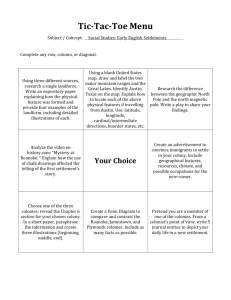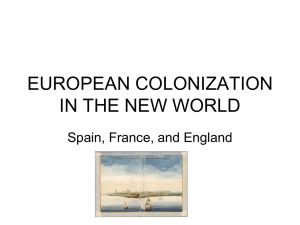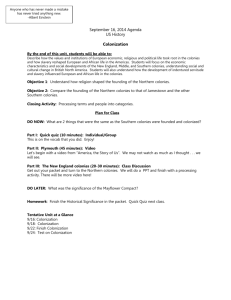File
advertisement

1 – Unit 1 – Foundations to 1733 Charlotte Mecklenburg Schools American History 1 Foundations to 1733 Conceptual Lens: Exploration and Colonization Unit Overview: During the 15 th and 16th century, European social, political, and economic conflicts spurred new technology, growth, and exploration. While Old world powers began to compete for new world prizes, native populations were decimated and left to battle an ever increasing wave of immigrants and colonists. Spain began as the forerunner of new world colonization in the Southwest but was soon overtaken by English settlements on the East coast of North America. English settlements were created for a variety of reasons but primarily for economic gain and religious freedom. Colonists within English settlements soon established interconnected societies that were highly developed and showing signs of unity that the Britain would soon have to come to grips with. [Unit 1] 2 – Unit 1 – Foundations to 1733 Exploration, Settlement and Expansion Reasons for colonization Life in the colonies Geographic and Economic differences in the colonies Mercantilism International Affairs and Foreign Policy CONCEPT/CONTENT WEB Conflict and Compromise Europe’s conflict over America Issues with Native Americans Conflict between established settlements vs. people on the frontier Conflict in culture (natives and colonists) European control in North America (British, Spanish and French) Freedom, Equality and Power Origins of English rights Religious tolerance Government in the colonies Military spending in the colonies Slavery in the colonies Great Awakening Religious movement UNIT 1 Foundations to 1733 European alliances with Native Americans Defeat of the Spanish Armada by the British Rise of King George II War English wars influence colonies Frontier wars influence colonies British and French competition to control North America (result of Queen Anne’s War) Progress, Crisis and the American Dream Emergence of 3 regions within the colonies Mercantilism and triangle trade Slavery vs. Indentured Servants What is the American dream for early settlers, Africans, and Native Americans. Benjamin Franklin and Poor Richards Almanac 3 – Unit 1 – Foundations to 1733 Enduring Understandings (Generalizations) and Essential Questions: 1. Technological change leads to new world exploration a) How did new technology spur exploration? b) What motivation existed for exploration around the world? c) How did explorers and colonists justify their risks in exploring and settling the New World? 2. Push and pull factors create massive demographic changes a) b) c) d) e) f) Why did European nations explore and colonize the New World? How and why did various religious and/or ethnic groups immigrate to the colonies and the United States? In what ways did the purpose and focus of settlement affect the development of each colony? How did the diversity of the populations in each region lead to varied experiences economically, socially, and politically? How did the concept of individual liberty play in the motivations of settlers in the New World? What role did conflict between European settlers and native populations have on future settlement? 3. Geography may cause diverse settlement patterns of people a) How did environmental factors, such as topography, climate variations and disease, influenced the settlement and development of the thirteen English colonies in North America? b) How did cultural factors influence the settlement and development of the thirteen English colonies in North America (e.g., Quakers in Pennsylvania, Puritan families in New England, indentured servants and slaves in Virginia)? c) How did the system of mercantilism led to “Triangular Trade” and the economic development of Great Britain and the colonies? d) How British colonists persevered in the face of harsh conditions to colonize North America? 4. Colonies can be socially, economy, and politically, diverse. a) How did the Great Awakening impact colonial religious, family and educational practices? b) To what extent were each of the thirteen original English colonies culturally diverse? c) To what extent did early English colonies rely on African slave labor to survive and prosper? d) How were various racial and ethnic groups who aided the settlement and expansion of the United States either accepted or discriminated against? e) How and why did various religious and/or ethnic groups immigrate to the colonies and the United States? f) How did land policies and inheritance laws expand opportunities for settlers in the British colonies? g) How did colonial rights and privileges as Englishmen, established in England, influence the development of colonial political life? 5. Ambition and power can create conflict within a society a) How did English Civil Wars and the Glorious Revolution of the 17th Century impact the political development of the British colonies? b) How and to what extent would colonial expansion and various frontier wars with American Indians influence the political development of the colonies? c) How did various groups of American Indians influence the settlement and expansion of the European colonies and the United States frontier? 4 – Unit 1 – Foundations to 1733 Unit Vocabulary Tier 1 Tier 2 Tier 3 Fight War Believe Change Motivate Religion Explore Justice Farm Pride Families Politics Voting Unite Money Town Meetings Ethnic diversity Nationalism Reformation Charter Indentured Servitude Toleration Autocratic Asylum Proprietary Dissenter Civil War Middle passage Hierarchy Stratification Secular Empire Sect Theocracy Covenant Bacon’s Rebellion King Phillip’s War Salem Witch Trials Halfway Covenant Powhatan War 13 colonies Dominion of New England Starving time Roanoke Mayflower Compact Pequot War Iroquois Confederation Headright System Plantation system Middle Passage Triangular Trade Slave Maryland Toleration Act Primogeniture 5 – Unit 1 – Foundations to 1733 Key People Metacom William Bradford John Winthrop Sir Walter Raleigh John Smith Pocahontas John Rolf Thomas Hooker William Penn Lords Proprietors French Huguenots James Oglethorpe Anne Hutchinson Roger Williams Chief Powhatan By the end of this unit, students should be able to state… I can analyze various texts to understand the role religion played in the creation of new settlements in the Western Hemisphere I can explain how conflicts in Europe resulted in mass migration and a race for expansion I can evaluating competing narratives on the effects of Columbus’s discovery of the “New World” I can use maps, charts, and data to track demographic change between Europe and the new world as well as the evolution of settlements in the Western Hemisphere I can explain how the desire for economic security and adventure resulted in a change in the environment and population distribution I can compare and contrast colonies and motivations for their settlement I can explain how individuals in their desire for profit can negatively impact the environment I can analyze cause and effect relationships based on race, class, and religion in the new colonies I can use multiple examples to explain the creation of a distinct American identity I can explain the social, economic, and political tensions that led to violent conflicts between the colonists and their governments I can describe the role religion played in the creation of colonies and how those beliefs changed over time I can explain how the desire for religious freedom led to conflict and change in national and regional demographics I can identify important individuals and explain their impact on the creation and evolution of North American society I can track the evolution of indentured servitude and African American slavery in the colonies I can trace the arrival of Africans in the European colonies in the 17th century and the rapid increase of slave importation in the 18th century I can assess the importance of servitude and slavery to the creation of the new world I can describe attempts by European countries to control their respective colonies and in what ways those colonies responded to those attempts at control I can formulate historical questions on the evolution of self-government in the new world and how that led to both attempts unity and conflict I can Analyze how various Native American societies changed as a result of the expanding European settlements and how they influenced European societies 6 – Unit 1 – Foundations to 1733 Performance Tasks and Scoring Guides/Rubric To the right is an example of an illustrated time line Generalizations: Technological change leads to new world exploration Geography will cause new diverse settlement patterns Push and pull factors create massive demographic changes New world colonies were socially, economy, and politically, diverse. What: This task is a culminating activity for age of exploration and colonization. It will reinforce information and give evidence of the students understanding of the content. Why: To assess the students understanding of the students How: creating an illustrating timeline Performance task Summary: You are in charge of creating an illustrated timeline to teach younger students about the age of exploration and the colonization of America. Not only will you create the illustrated timeline but you must also create an activity and assessment to go along with the time line to check student understanding. Performance Task Criteria: On legal size or butcher paper create a timeline of the significant events during the Age of Exploration and colonization. First find the year of each event, then put the events in order on a scrap sheet of paper and then write out a short description of the event. Next find or draw a picture that represents the event (make sure to cite your resource if you got the picture on line) Then, transfer them onto the butcher paper or legal paper (you may need more than one piece of legal paper). Next create an interactive activity and presentation for a class of 8th graders who are learning this information that uses your timeline to address what you think they should know about this time period. 7 – Unit 1 – Foundations to 1733 Performance Task Rubric: Historical and Statistical Analysis Organizer (illustrated timeline) - 40 points o All components completed in details (30 points) o Sources cited (10 points) Activity for younger students - 30 points o Includes connection to American History State Standards (10 points) o Allows for interaction (game, activity) How will students dive into the information? (10 points) o Includes a presentation for students that is appropriate and informational (10 Points) Assessment for younger students - 30 points o Includes at least 10 MC, 10 short answer and 2 essay questions (10 points) o All information presented correlates with the information from the unit (10 points) o Includes proper spelling and grammar (10 points) Unit Resources 8 – Unit 1 – Foundations to 1733 Unit Number- 1 Foundations to 1733 Resource Title Stanford History Experiment Location http://sheg.stanford.edu/us Short primary document sets http://teachingamericanhistory.org/library/colonial/ Mayflower Compact http://www.mayflowerhistory.com/PrimarySources/MayflowerCompact.php Jamestown Government http://www.jamestown1607.org/democracy_v2.asp Summary Several primary document activities for essential content for the unit Overview of the colonial primary documents short enough to use in class. All links work The Mayflower Compact with an explanation of the significance of the document. The first government of Jamestown explained Orders and constitutions http://etext.lib.virginia.edu/etcbin/jamestown-browse?id=J1049 Sets up rules for the governing body of Jamestown Life and government of Jamestown Images of US History http://www.virtualjamestown.org/fhaccounts_desc.html Source for multiple primary sources surrounding life and government regulation in Jamestown This website has images from throughout US history. Use the menu on the left to choose topic. John Smith Primary Source http://www.nvcc.edu/home/preed/starvingtimesup.htm John Smith’s account of hardships at Jamestown Edenton, NC http://www.learnnc.org/lp/editions/nchist-sampler/4424 Indentured Servitude http://www.learnnc.org/lp/editions/nchist-sampler/4424 Primary map of colonial Edenton, NC with guiding questions to interpret daily life from map information. Story of an indentured servant in Virginia in the 1600’s Atlantic Slave Trade Video http://history.howstuffworks.com/30011-assignment-discovery-the-middlepassage-video.htm Short video clips on the Slave Trade Voyage to America http://www.learnnc.org/lp/editions/nchist-colonial/1902 People of the colonies http://www.learnnc.org/lp/editions/nchist-colonial/4116 The Middle Passage http://www.pbs.org/wgbh/aia/part1/1narr4.html Letter from a German colonist describing the sea voyage and life in the colonies The journal of William Byrd detailing the people and land of the Virginia and NC boundary Middle passage overview and primary documents. Goes great with PBS video “Slavery in America” http://ushistoryimages.com/









